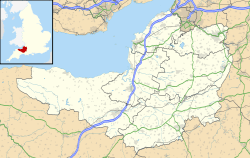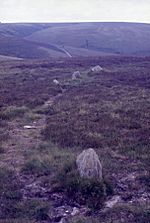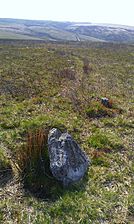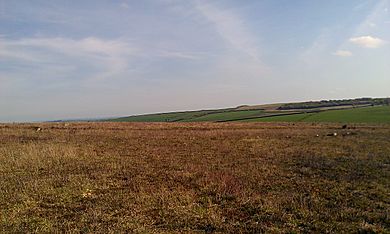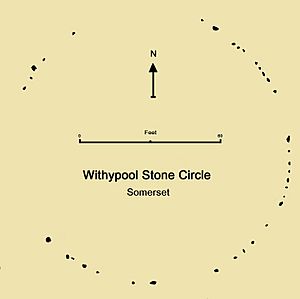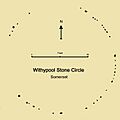Withypool Stone Circle facts for kids
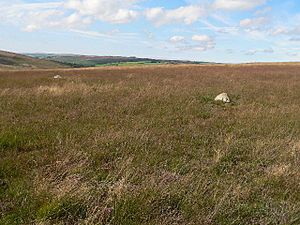
The location of the circle in 2005; the stones are so small that discerning the site is difficult
|
|
| Location | Withypool |
|---|---|
| Coordinates | 51°05′47″N 3°39′37″W / 51.0963°N 3.6604°W |
| Type | Stone circle |
| History | |
| Periods | Neolithic / Bronze Age |
The Withypool Stone Circle, also known as the Withypool Hill Stone Circle, is an ancient stone circle. You can find it on the Exmoor moorland, which is open, uncultivated land. It is close to the village of Withypool in the county of Somerset, in the southwest of England.
This stone circle is part of a tradition of building similar monuments across Britain, Ireland, and Brittany (in France). These circles were built a very long time ago, between 3300 and 900 BCE. This period is known as the Late Neolithic (New Stone Age) and Early Bronze Age. We don't know for sure why these monuments were built. However, archaeologists think the stones might have represented important spirits or gods to the people who built them.
Many ancient monuments were built on Exmoor during the Bronze Age. But only two stone circles are still standing today. The other one is the Porlock Stone Circle. The Withypool circle is on the southwest side of Withypool Hill, in an area of heathland. It measures about 36.4 metres (119 feet 5 inches) across. Today, about thirty small gritstones remain. Originally, there might have been around 100 stones. There are clear gaps where stones are missing on the north and west sides. The site was found again in 1898 and studied by archaeologist Harold St George Gray in 1905.
Contents
Where is the Withypool Stone Circle?
The Withypool Stone Circle is located on the southwest slope of Withypool Hill. Some people call it the Withypool Hill Stone Circle because of its location. The site is high up, at 381 metres (1250 feet) above sea level. It is about 670 metres (733 yards) east of Portford Bridge. It's also about 4.4 kilometres (2.75 miles) south-southwest of Exford.
The ground at the site slopes down from east to west. The top layer of soil is peaty and covered with heather plants. You can see many different Bronze Age round barrows (ancient burial mounds) in the area around the circle.
For example, there's a single burial mound 262 metres (286 yards) northeast of the circle. This mound is on top of Withypool Hill. However, it is so worn down that you can't see it from the stone circle anymore. You can also see the three Brightworthy Barrows from the circle, looking northwest. Other Bronze Age mounds visible from the circle include the Green Barrow, the Old Barrow, the Twitchen Barrows, and the three Wam Barrows on Winsford Hill. There's also a mound on top of Sherdon.
Near the circle, on the Westwater Allotment, there are more than thirty scattered stones. These stones are up to 0.5 metres (1.6 feet) long. In 1988, two of them were reported to be standing upright. Elsewhere on Withypool Common, there are six stones arranged in a rough circle. This might have been another stone circle, or perhaps the edge stones of a round cairn that has since been destroyed.
Why Were Stone Circles Built?
During the Early Neolithic period (around 4000-3000 BCE), people built large monuments like long burial mounds and large circular enclosures. But by 3000 BCE, things changed. People started building different types of circular monuments. These included earthen henges, timber circles (made of wood), and stone circles.
Stone circles are found in most parts of Britain where natural stone is available. They are most common in southwest Britain and northeast Scotland. People built these circles for a very long time, from about 3300 to 900 BCE. The main period of building was between 3000 and 1300 BCE.
Archaeologists have found very little evidence that people visited these stone circles often right after they were built. This suggests they weren't used for everyday rituals that would leave behind many objects. Instead, they might have been left as "silent and empty monuments."
Some archaeologists, like Mike Parker Pearson, believe that in Neolithic Britain, stone was connected to the dead, while wood was connected to the living. Other experts think the stones might not have represented ancestors. Instead, they could have stood for other powerful, unseen beings, like gods.
Stone Circles on Exmoor
There are only two known prehistoric stone circles on Exmoor: Withypool and Porlock Stone Circle. An archaeologist named Leslie Grinsell thought that a circular stone monument on Almsworthy Common was probably another stone circle. However, more recent studies suggest it's actually a stone setting, which is a different type of monument more common on Exmoor.
Archaeologists believe these Exmoor circles were built in the Late Neolithic or Early Bronze Age. They are similar to the stone circles found further south on Dartmoor. However, Dartmoor has over seventy such monuments, while Exmoor only has two. This difference might be because Exmoor does not have natural granite, which is a very hard rock. Instead, Exmoor has Devonian slates and Hangman Grits. These rocks break easily into small pieces, so there aren't many large stones on Exmoor.
This lack of large stones might explain why ancient communities used small stones, sometimes called miniliths, in the two Exmoor circles. They also used them in other monuments in the area. However, there are other structures nearby, like the clapper bridge at Tarr Steps and the three-metre-tall Long Stone at Challacombe. These use large local stones. This suggests that bigger stones were available if the builders wanted them. So, using small stones might have been a deliberate choice.
Exmoor also has a henge near Parracombe, though it has been damaged by farming. The moor also has many other Bronze Age monuments. These include 300 to 400 round burial mounds, standing stones, linear stone rows (lines of stones), and stone settings. The fact that people built so many different types of monuments might also explain why so few stone circles were created here.
Most of the ancient stone monuments that still exist on Exmoor are in areas of moorland that were not used for farming in medieval and later times. This means that the sites we see today might not show the full number of monuments that once existed.
What Does the Stone Circle Look Like?
The Withypool Stone Circle measures 36.4 metres (119 feet 6 inches) across. In 1905, there were 37 stones left in the circle. At that time, there were clear gaps on the north and west sides. The stones from these areas might have been taken away to be used as material for roads. You can still see dips in the ground where some of these stones were removed.
In 1915, it was reported that one stone had been removed, but three new ones had been found in the circle. By 1988, Martin J. F. Fowler reported that only 29 stones remained. The next year, archaeologist Aubrey Burl counted 30 stones. Of these, three had fallen over, and 27 were still standing. Originally, the circle might have had around 100 stones, placed about one metre (3 feet 3 inches) apart.
The stones themselves are quite small. On average, they are about 10 centimetres (4 inches) high, 30 centimetres (one foot) wide, and 10 centimetres (4 inches) deep. The largest stone sticks out about 0.5 metres (1 foot 8 inches) from the ground. Most of the stones are broken, probably since the circle was first built.
We don't know if all the stones came from the same type of rock. However, one stone was tested and found to be a hard, pale grey gritstone. This stone likely came from the nearby Pickwell Down grits. Many of the stones in the circle have clear white lines of quartz running through them.
How Was the Circle Discovered and Studied?
The Withypool Stone Circle was found again by accident in 1898. Archibald Hamilton was riding his horse across Withypool Heath when his horse stumbled on one of the stones. When he looked closer, he found other stones hidden in the bracken (a type of fern). After farmers burned the bracken on the heath, Hamilton returned to examine the circle more carefully.
He contacted Colonel Bramble, who was a leader of the Somerset Archaeological and Natural History Society. Bramble then connected him with the archaeologist Harold St George Gray. Gray went with Hamilton to visit the site in August 1905. During this visit, Gray made a full map and study of the stone circle.
Gray published what he found in a 1906 book by the Proceedings of the Somerset Archaeological and Natural History Society. In his report, he compared the Withypool circle to two stone circles in Cornwall that he had recently studied: Fernacre and Stannon Stone Circle. Gray thought that the Withypool circle might have been a place where people performed cremations (burning bodies). He believed the ashes were then buried in the nearby mounds.
In August 1915, Gray visited the site again. He noted that the circle was mostly in the same condition as before. However, the ling (heather) and whortleberry bushes around the site were smaller than they had been. Between 1982 and 1985, Martin J. F. Fowler visited Withypool Stone Circle and other ancient stone monuments on Exmoor. He included them in a list published in a 1988 edition of the Proceedings.
The Withypool Stone Circle has been protected by law as a scheduled monument since 1925. This means it is legally protected under the Ancient Monuments and Archaeological Areas Act 1979. In the Historic England database, it is listed with the number 1021261.
Images for kids


